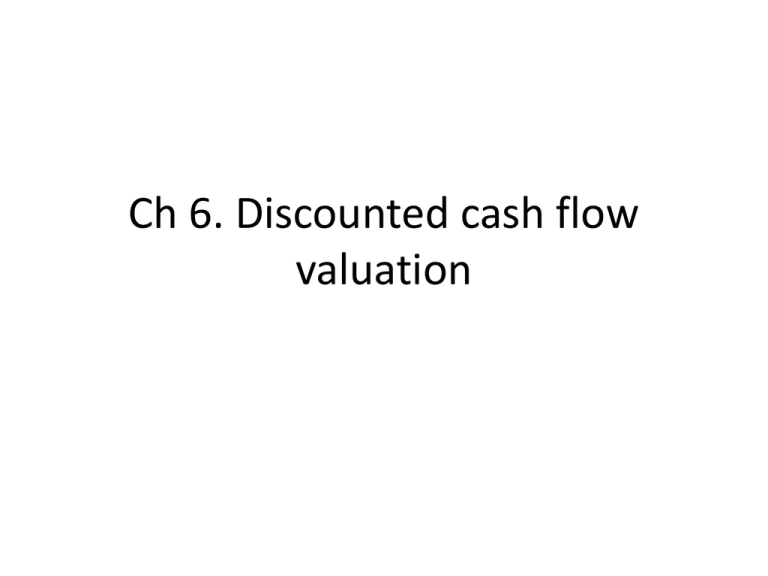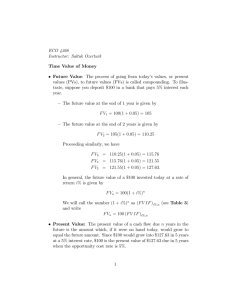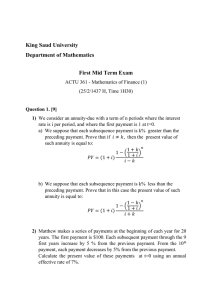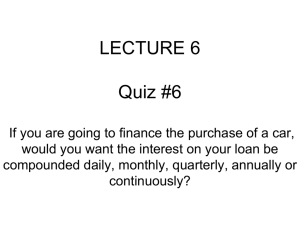Ch 6
advertisement

Ch 6. Discounted cash flow valuation 1. FV and PV with multiple cash flows 1) FV with multiple cash flows: Two methods (1) Rolling over FV year by year (2) FV=FV1+FV2+FV3…. Ex) Deposit $100 every year for 3 yrs. And 10% interest rate. FV? 2) PV with multiple cash flows: Two method (1) Rolling back year by year (2) PV=PV1+PV2+….. Ex) You are supposed to need $1000 in one year and $2000 in the second year. If you can earn 9% on your money, how much you have to put up today? 2. Annuities and Perpetuities 1) Def of Annuity: Constant cash flows for a fixed period of time Ex) car loan Ex) Assets with promised to pay $500 at the end of the each of the next three years. What is the price of the asset now if a discount rate is 10%? Answer: 500/(1.1)+500/(1.1^2)+500/(1.1^3)= 1243.43 2) Formula for Annuity Present Value C [1 1 /(1 k )t ] PV k C C C PV ..... 2 (1 k ) (1 k ) (1 k ) t C C C PV (1 k ) C ..... 2 (1 k ) (1 k ) (1 k ) t 1 C PV PV (1 k ) C t (1 k ) 1 PV ( k ) C[ 1] t (1 k ) 1 C[1 ] t (1 k ) Therefore PV k Ex) You stop by a car dealer shop and find a really good car. The sticker price of the car is $15000. But you don’t have money now. So, want installment payment over 4 yrs. Over conversation, the dealer suggests $632 per month for 48 month at 1% per month. How much is going to be your PV of total installments? 2-2) Finding C Ex) You stop by a car dealer shop and find a really good car. The sticker price of the car is $15000. But you don’t have money now. So, if you want installment payment over 4 yrs, how much you have to pay monthly? (Here interest rate is 12%) 2-3) Finding rate Ex) an insurance company offers to pay you $1000 per year for 10 years if you pay $6710 up front. What rate is used in this annuity? 3) Def of perpetuities: An annuity in which the cash flow continues forever 4) Formula for PV of perpetuities PV=C/k Ex) Preferred stock – promised fixed dividend every period forever. A company want to sell preferred stock at $100 per share. How much of dividend it has to pay. Currently the similar preferred stock is sold at $40 with $1 dividend. i) Calculate r: R= 1/40 = 0.025 ii) Calculate C: 100 = C/0.025. Then, C=2.5 5) FV for Annuities FV C [(1 k ) 1] / k t FV C C (1 k ) C (1 k ) ...... C (1 k ) 2 t 1 FV (1 k ) C (1 k ) C (1 k ) 2 C (1 k )3 ..... C (1 k )t FV FV (1 k ) C C (1 k )t FV (k ) C[1 (1 k ) ] t C[(1 k )t 1] FV k Ex) $2000 annuity for 30 years and k= 0.08. What is the annuity future value? 6) Annuities due Def: annuity for which the cash flows occur at the beginning of the period Annuity due value = ordinary annuity value * (1+k) • 7) Uneven Cash Flows; • Summing PV and FV of each cash flows • Using the cash flow patterns to apply formula • 8) Growing annuities: payment growth by g%. 1 g t 1[ ] 1 k ] PV C [ kg • 9) Growing perpetuity: payment grows by g% forever. PV C /( k g ) 3. Rate Q1. 10% compounded semi-annually is the same as 10% per year in compounding? No! here, 10% is APR, (annual percentage rate) and actually, 10.25% (=(1+0.05)*(1+0.05)-1) is the effective annual rate. To compare to other rates, we need to convert APR into the effective rates 3-1) APRs (Annual Percentage Rate) Def: interest rate charged per period (periodic rate) multiplied by the number of periods per year APR =EAR? No!!!! So, APR is a quoted rate and need to be converted to the EAR EAR(Effect ive Annual Rate) [1 (APR/m)] m 1 unlimited interest calculatio n EAR e k 1 e 2.71828 Ex) One credit card company selling a card by telemarketing. The company said the card will benefit its cardholders with semi-annual 15%APRs, compared to the other credit card with 16% EAR. Do you agree or not? 6.Loan types and loan Amortization 1) Pure discount loan: Receive money today and repay a single lump sum in future What is the price of loan that you will pay $25,000 in 5 years? A lender wants to apply 12% interest rate. 14,186 = 25000/(1.12)^5 2) Interest only loan: Pay interest each period and repay the entire principal at some point in the future • A three year, 10% interest only loan of $1000. • A borrower has to pay $100 at the end of first and second year. At the end of third year, he or she has to pay $100 and $1000. • 3) Amortized loan: Repay parts of the loan amount over time • Borrow $5000 for 5 years. An interest rate is 9%. Annual payment happens. • 3-1) constant principal payment Year Begin Pay Interest paid Principa End l 1 5000 1450 450 1000 4000 2 4000 1360 360 1000 3000 3 3000 1270 270 1000 2000 4 2000 1180 180 1000 1000 5 1000 1090 90 1000 0 6350 1350 5000 total 3-2) Fixed payment • 5000 = c*[1-1/(1+0.09)^5]/0.09 • C=1285.46 Year begin pay interest principal End 1 5000 1285.46 450 835.46 4164.54 2 4164.54 1285.46 374.81 910.65 3253.88 3 3253.88 1285.46 292.85 992.61 2261.27 4 2261.27 1285.46 203.51 1081.95 1179.32 5 1179.32 1285.46 106.14 1179.32 6427.30 1427.31 5000 total







